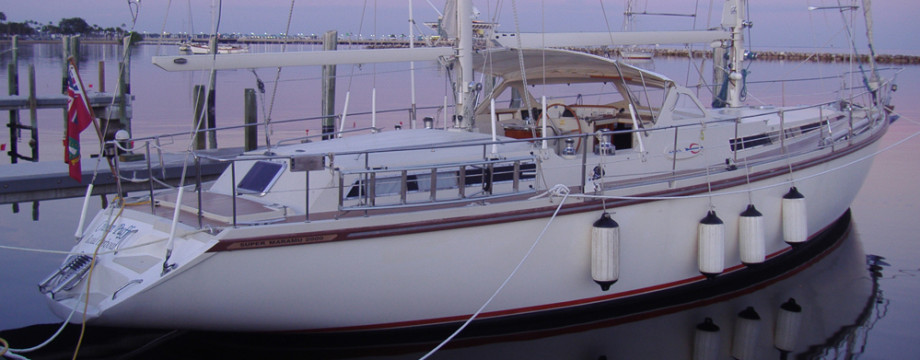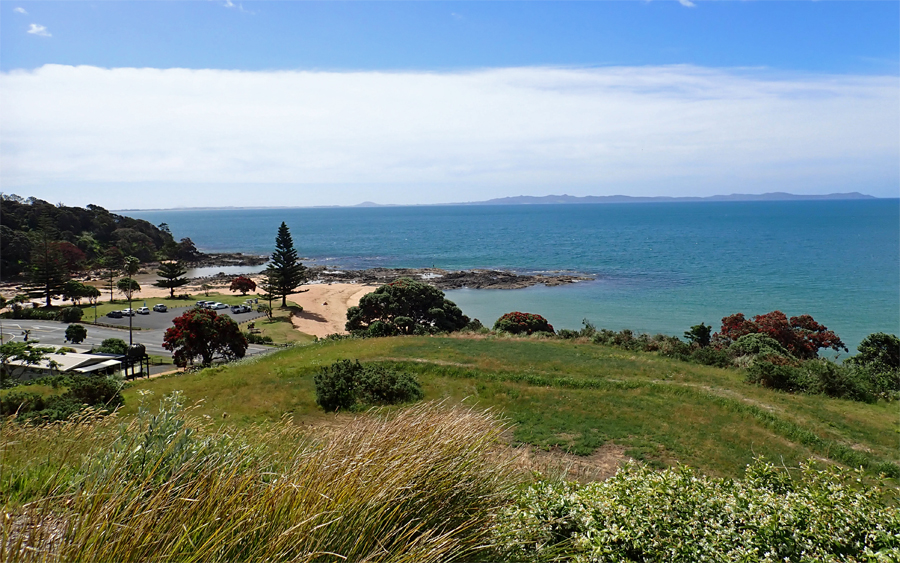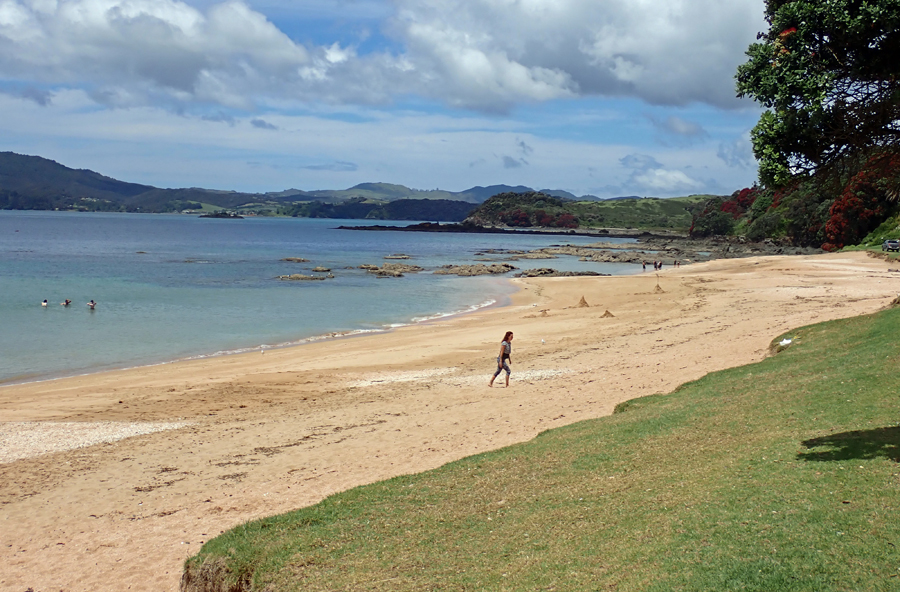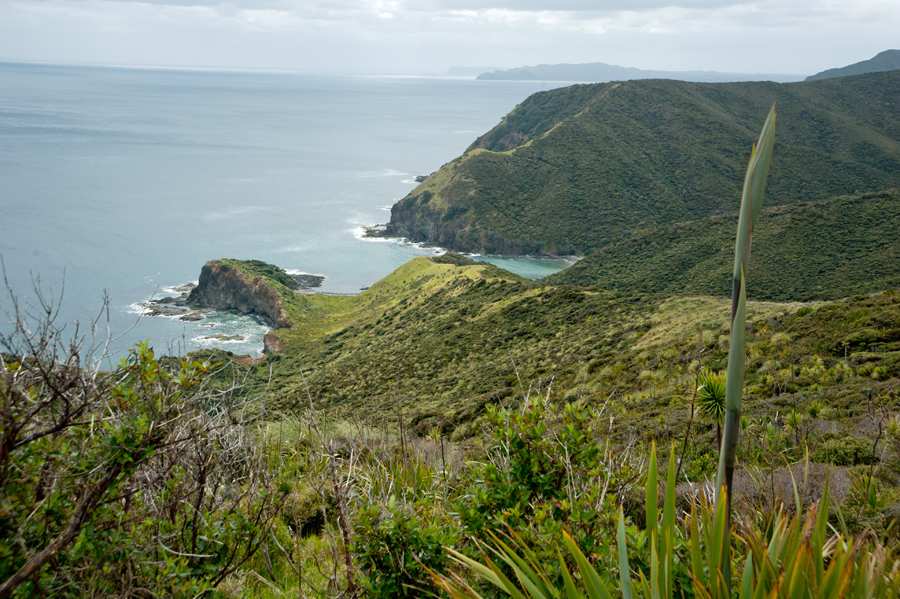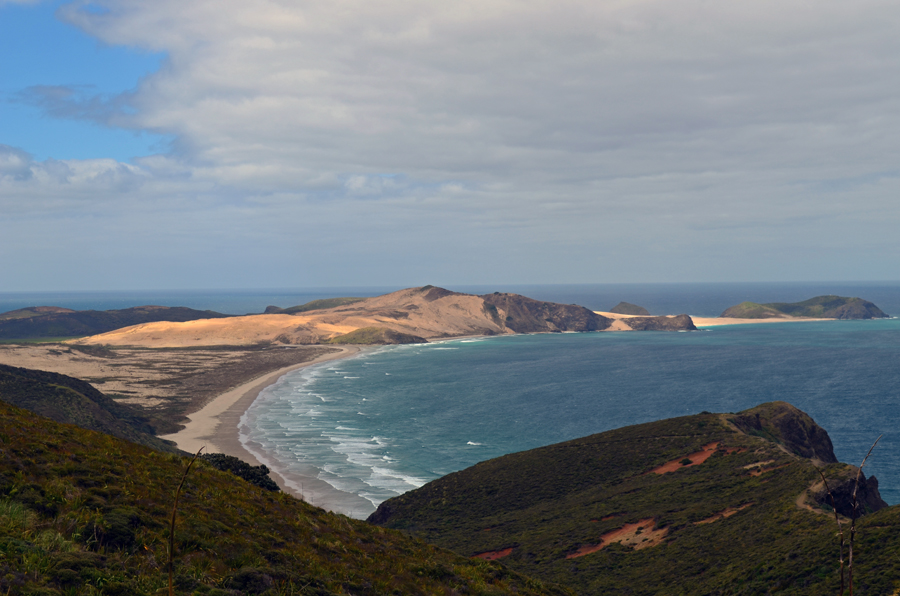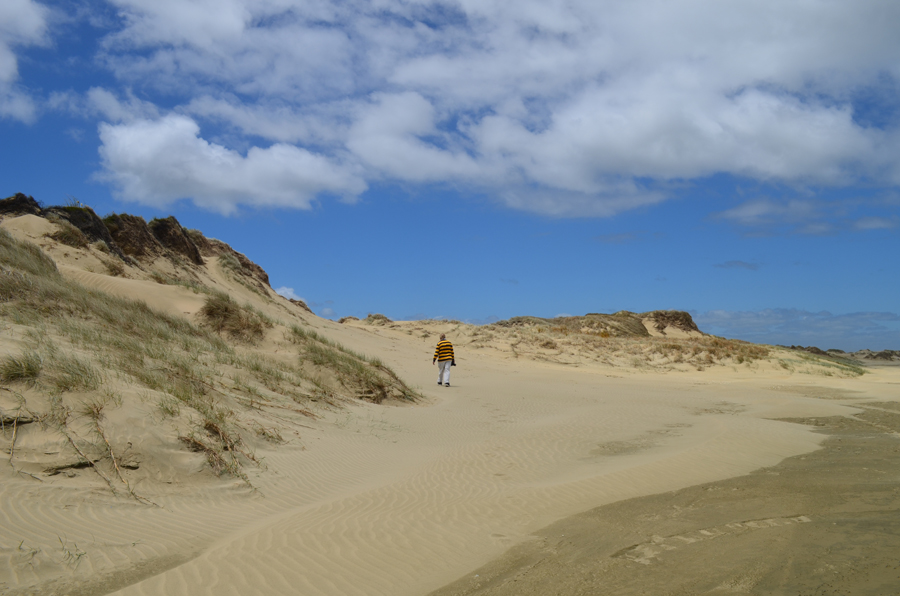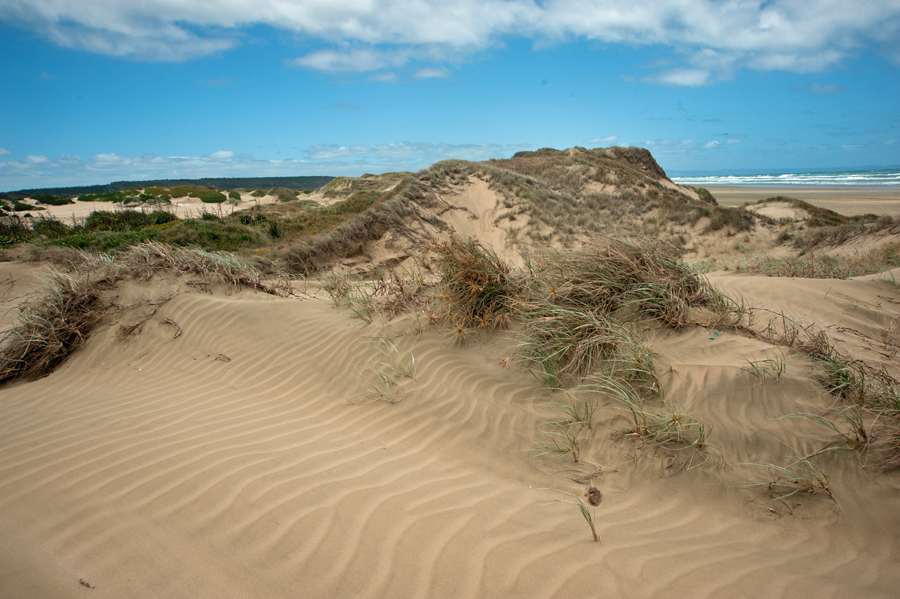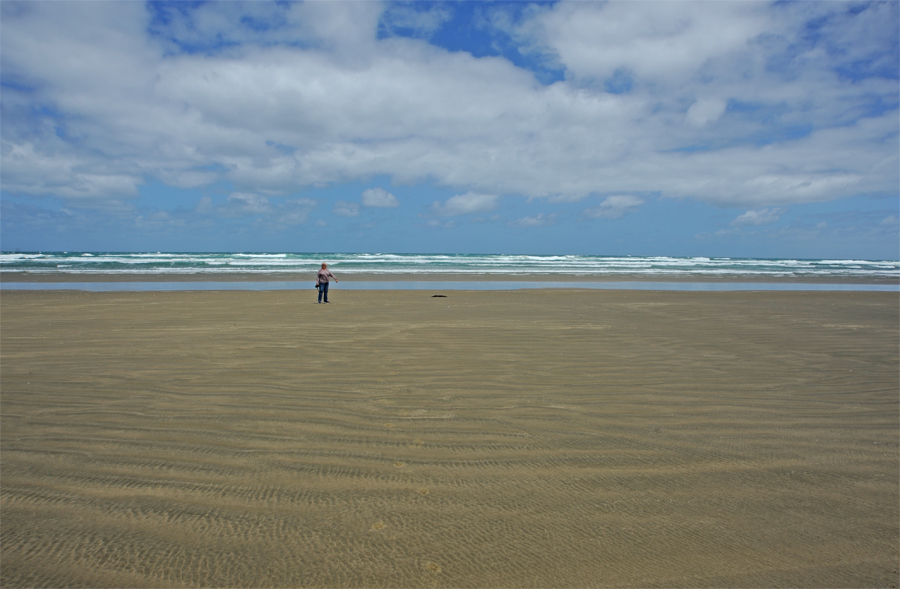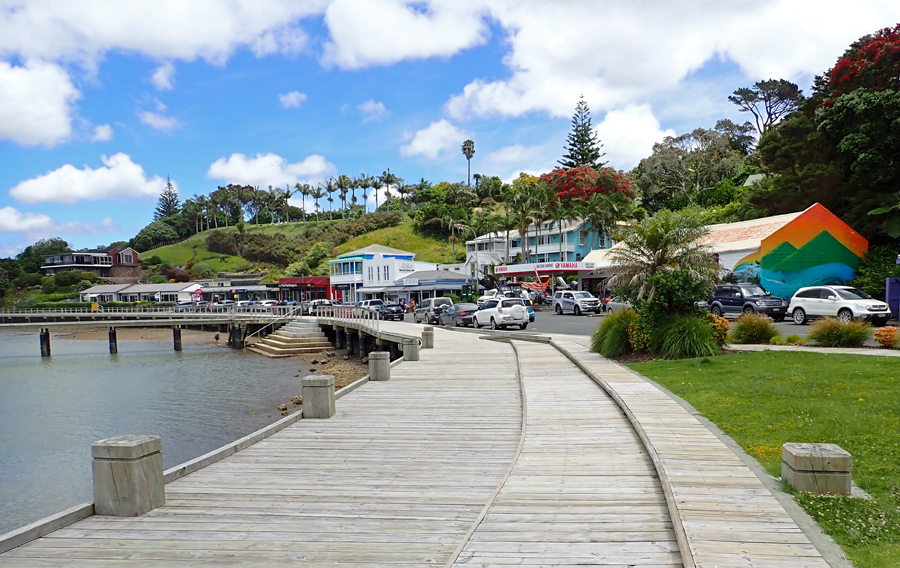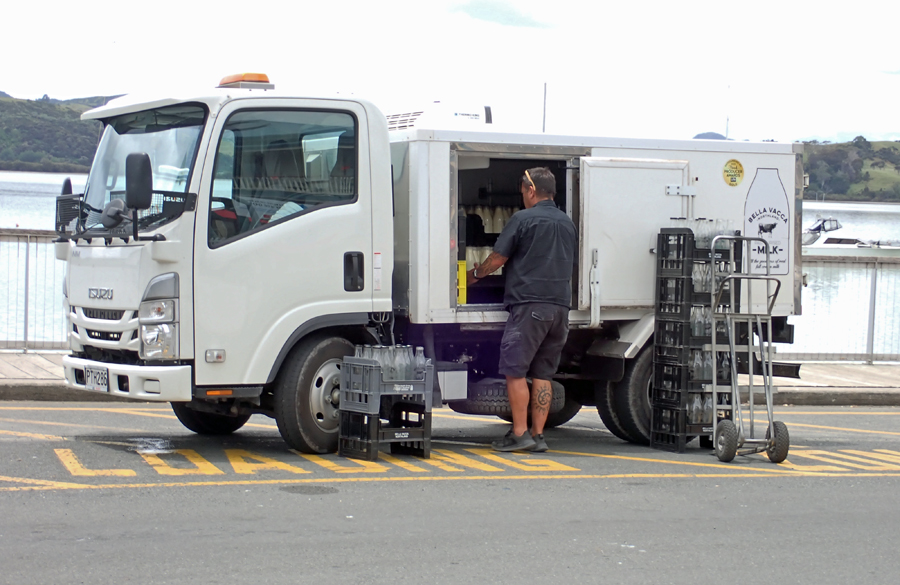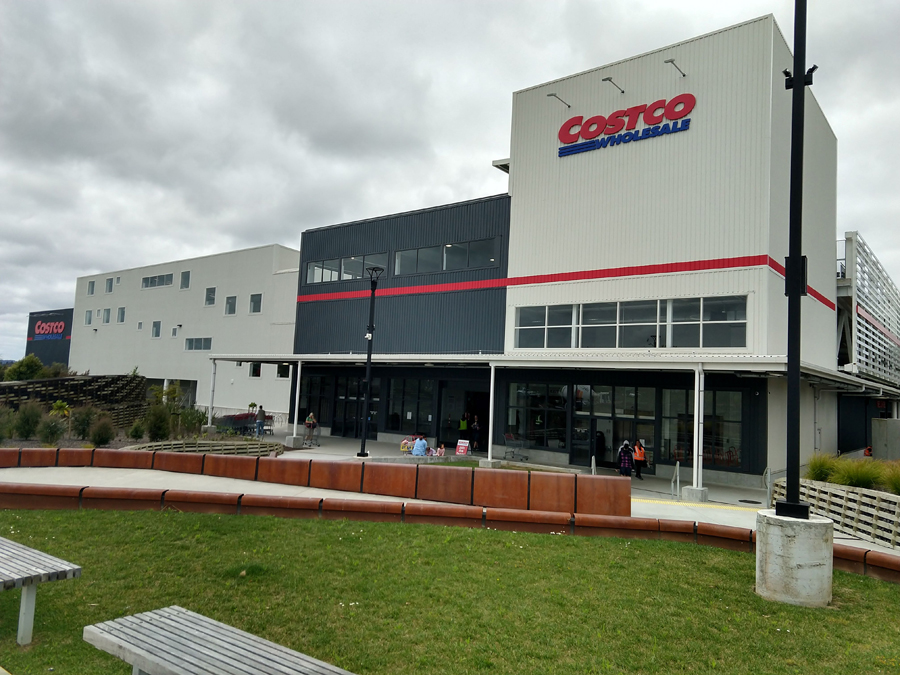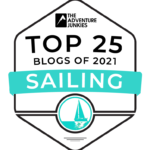Happy New Year. And, Happy Cream Puff Day. Yes, it is such a thing. January 2nd in the USA is Cream Puff Day – Google it if you don’t believe me. Amel boats are French as are Cream Puffs. French chef Antonin Carême was the first to add cream to puffs in the early 19th century.
Yay! We are exploring. We rented a car from a company called RaD. The company was founded in the mid-1980s and was originally called Rent-a-Dent. I imagine it didn’t take a public relations professional very long to point out the name kinda sorta has a negative connotation.
The car we rented was a 5-door Mazda with almost 200,000 km on it. However, it was clean, ran well, and the price was right. I wore a tie-dye tee when we picked it up and the agent told us the car would match my shirt. He was right. We had no trouble finding it in parking lots.
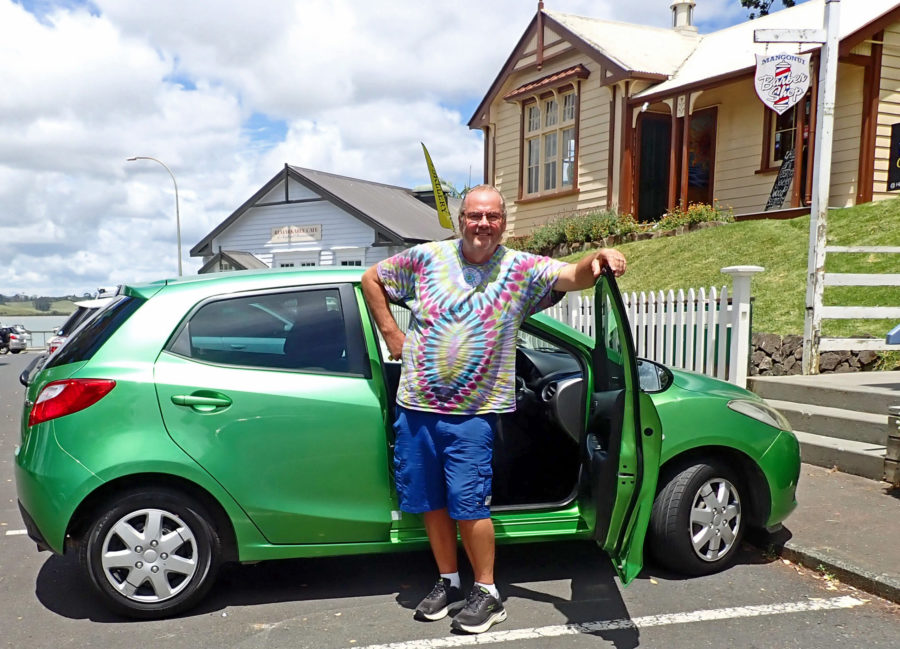
I stand out in New Zealand since most people here don’t seem to wear bright colors. Even the majority of cars are black, white, or grey. Several people point to my tie-dye shirts and tell me they like them.
We considered buying a car here since we plan to stay for the duration of the cyclone season. After a quick look at the numbers, the headache of vehicle ownership, and the potential cost if there is a mechanical failure, the RaD option, about a 10-minute walk from us, is going to prove to be a better deal.
Our plan is to explore as much of New Zealand as possible whilst here. Some of the excursions we have planned will be by bus or train. It doesn’t really make sense to own a car during these lengthy trips since we will rent a car at each destination. Also, the convenience of having RaD within a short walk of the Puffster means we can get a car for a day trip whenever we need to.
The first thing we discovered is fuel here is expensive. Petrol (gas) is about NZ$2.72 per liter (US$1.70 or 1.55 euros – US$6.46 per US Gal). The next thing we discovered is there are hardly any people living in New Zealand. As a comparison, we lived in Atlanta in the USA where the metro population is 6.1 million people. The UK, which is 243,610 km2, has a population of 67 million people. New Zealand, which is slightly larger than the UK with 270,534 km2 has less than 10% of the UK population or about 5.2 million people. Yes, this entire country has fewer people than the city in which we used to live in the USA.
We learned by watching a local morning show that New Zealand is having difficulty with underemployment. Quite a few industries have more job openings than applicants. This is especially true in the healthcare system. More than one local has told us that getting a General practitioner (GP) is just about impossible. What is the point of having a socialized medical system if you can’t get in to see a doctor? The lady on the television said people with healthcare skills don’t want to live in New Zealand. I don’t think she is correct about this.
After going through the extended visa process, it is pretty obvious to us that New Zealand doesn’t want to have foreign people live here. That is unless they have oodles of money and are willing to make a substantial investment into New Zealand. And, I mean oodles of money. If people are over 55, then just forget it. These are the least welcome. In just about every other country we’ve visited, if we can prove we can financially support ourselves, have healthcare insurance, and a non-criminal background, staying for an extended period is not a problem. But, not in New Zealand.
Speaking of paying the government, I lost a lot of respect for New Zealand during Covid and the government’s willingness to be paid off for exceptions to their travel bans. I see the same with their visa applications. Give them a big wad of money and the rules change.
During Covid, New Zealand was one of the first countries to close their borders. This met with favorable results health-wise since they managed to keep exposures to a minimum. However, during the lockdowns, many people with New Zealand citizenships were prevented from returning home. The most widely known account was Trevor Ponting, a Kiwi living in Japan.
He was diagnosed with terminal brain cancer and was denied his emergency request to return to see his family for the last time because his case “wasn’t urgent enough”. Social media eventually placed enough pressure and forced the government to go back on their decision. He died a couple of months after returning. During this time, New Zealand was allowing boaters, like us, to enter the country if they agreed to spend NZ$30,000 on parts or work related to their boats. They also allowed athletes to enter and compete, including The America’s Cup.
And yes, I agree that looking back at Covid many mistakes were made by countries all over the world. However, I believe if rules are made, they should apply to everyone. Else, don’t make the rule. I also believe in a time of crisis a government’s responsibility should be to the citizens, all of them, regardless of where they are located. Placing money and sporting events over fellow citizens isn’t cool. Perhaps I’m naïve.
Another thing noticed almost immediately is potholes. We expect bad roads in poor countries. But, it was a surprise here. The closer we get to Auckland, the better the roads. Our travels initially took us northward and even the main roads were in pretty bad shape. We ventured as far as the road allowed us to Cape Regina. This is where the Pacific Ocean meets the Tasman Sea.
The drive north was scenic. The countryside is green with rolling hills. We opted to stay in a condo for a couple of days to minimize windshield time while exploring the Northland. Cindy found us a great spot with views of Doubtless Bay.
We stayed at a condo at Coopers Beach on Doubtless Bay for a couple of nights. The place was awesome. Besides the fabulous view, the rooms sported new carpets and furnishings. It smelled new.
During a stroll on the beach, we spotted a store selling ice cream. Yum! This is where we met a British couple and spent the next hour chatting with them as we slowly ate our cones. We sat at a picnic table in the shade, the only one out of the sun. They were looking for a place to sit and we offered to share.
They had been in New Zealand for 3 months visiting relatives and were about to head back to Auckland and then the UK. Before leaving, they decided to take a last drive north. I have to say, it was refreshing to meet people so well-traveled and the conversation had nothing to do with boats. Not that we don’t enjoy meeting other boaters, but meeting people with a great sense of humor and quick to keep the conversation going was a wonderful way to pass some time. I love people who are great storytellers.
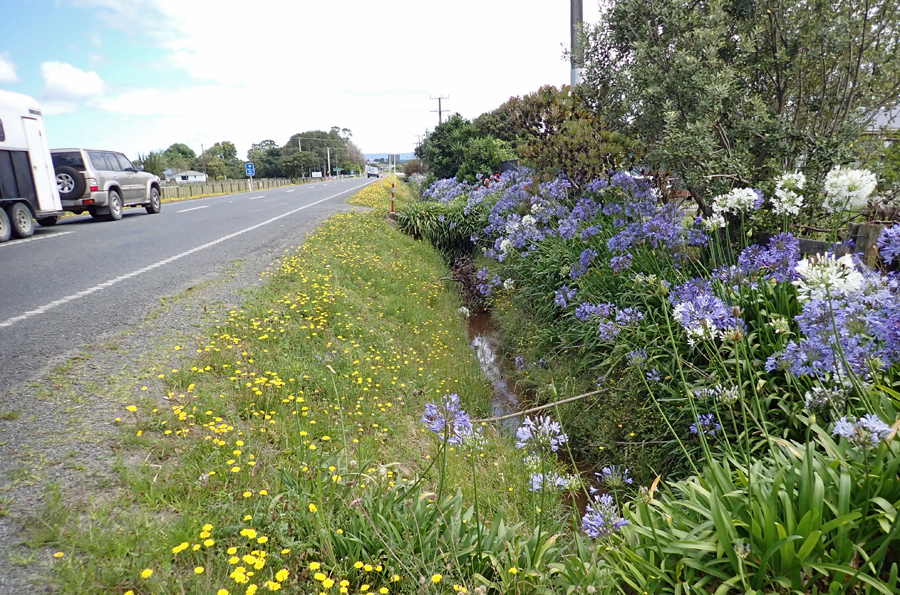
Everywhere we’ve gone so far has the road lined with these yellow flowers. This pic is not unusual. The purple flowers are agapanthus.
As we pushed our way north, it really felt like we were on a planet where cows and sheep rule. Once on the final stretch to the most northern point, we hardly saw other cars.
It is springtime here and the roads were lined with wildflowers. When I say springtime, I mean it isn’t warm. We have been in the tropics for so long that we’ve forgotten about seasons, or at least our bodies have. We’re not used to being cold. At the lighthouse, we are wearing warm sweaters and windbreakers.
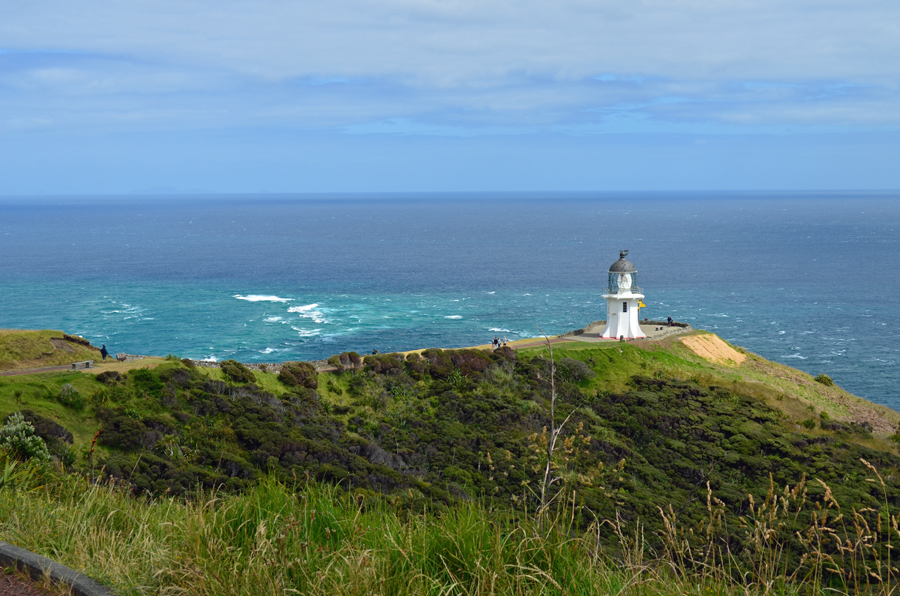
This is as far north as you can go in New Zealand without hiking off to North Cape. The turbulent water is due to current colliding from the South Pacific Ocean and the Tasman Sea
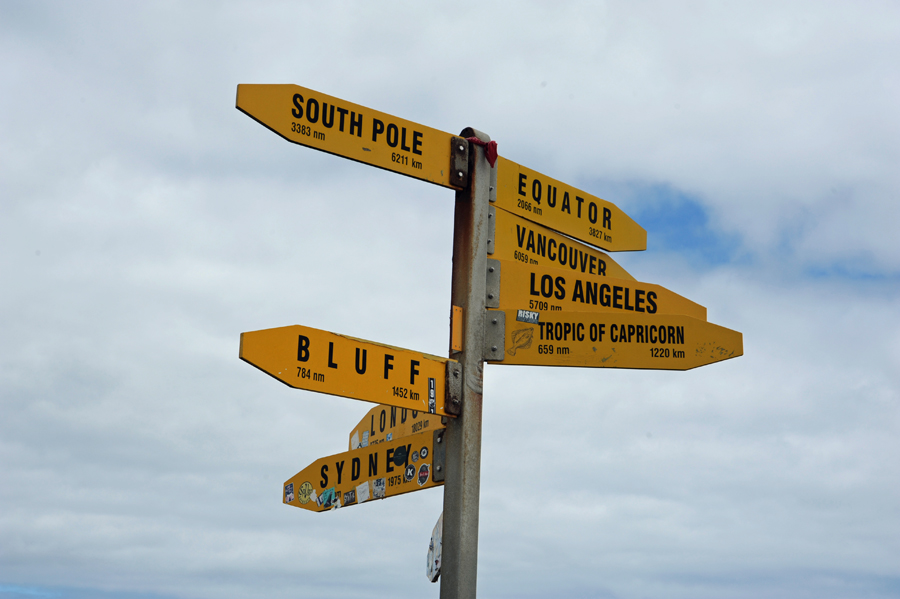
This is the first time I have seen a sign like this since we started out that has London and Los Angeles in opposite directions. Even in French Polynesia, it was shorter to travel eastward to London.
On the drive up to Regina Point, we notice a sign to 90-Mile Beach. We Googled it. Without reading too much to spoil the joy of finding out for ourselves what to expect, we decide on the way back to take the turn to see what lies down the road. I’m so glad we did.
We thought the main roads were bad. The sign off the main road said 90-Mile Beach was 10 km. What it doesn’t say is that the road surface disappears after the first 3 km and the road turns to a gravel lane riddled with gullies and ruts. We decide to push on at a pace of about 20-30 kpm (15 mph) as we are trying not to damage our rental car.
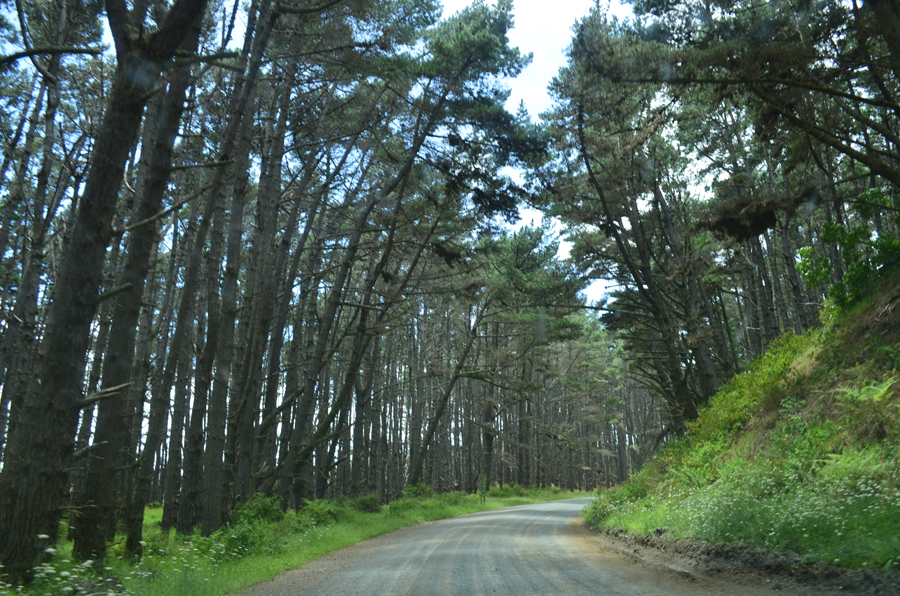
We found that once off the main roads, the tarmac disappears. Now we are cautious when going down sideroads to landmarks.
The contract for the rental car states we cannot drive on 90-Mile Beach. Honestly, it should have said we cannot drive on the road to 90-Mile Beach. Like most rentals, or hired cars as they call them here, we are responsible for the tires. I have a horrible gut feeling that if we spend any more time on this road, we’ll be buying tires. But, this wasn’t the case and the risk to get to the beach was well worth it.
The day was windy. But, at least it wasn’t raining as it has so often since we arrived here. We had to be careful opening the car doors. The breeze coming over the Tasman Sea hit us in the face at about 30 knots (35 mph, 55 kph). Once out of the car. The blowing sand stung our faces. I love beaches on windy days.
For as far as the eye can see in both directions up and down the beach, we are the only people. This time we don’t even have cows and sheep to keep us company. Just a few seagulls. A truck came down onto the beach and took off down the sand. I mean, it really took off. Within a few minutes, it disappeared over the horizon. Watching local TV, we learned there is some controversy about driving on beaches.
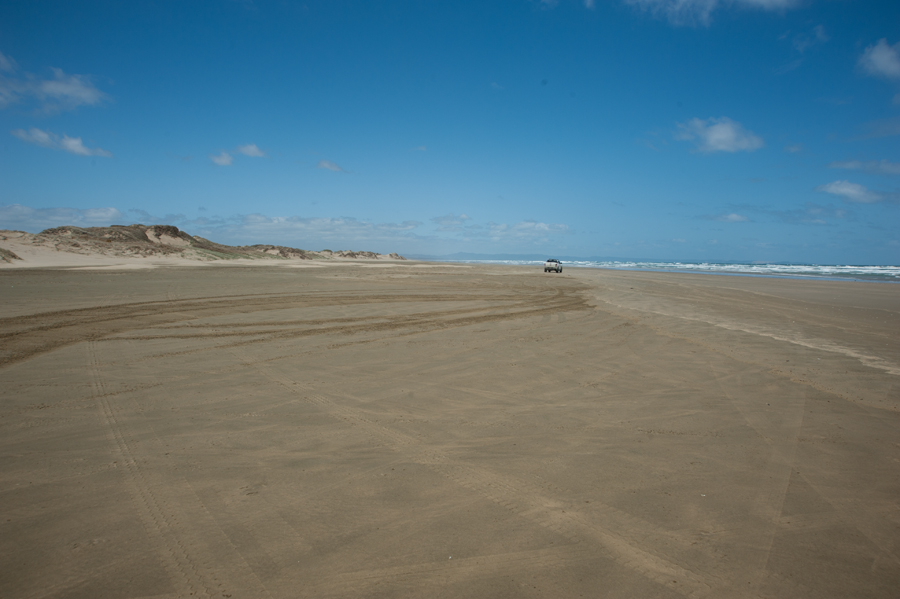
The only other people we see during our entire time there. This truck takes off over the horizon. We don’t see them again.
Driving on some beaches here is legal. People might take an ATV to their favorite fishing spot, or even launch a boat from the beach. The beaches are also popular spots for people with campers. The sand is packed hard and is frankly better than some of the roads we’ve been on. On one particular beach, Waimārama Beach on Hawkes Bay, an iwi leader decided to take matters into his own hands and placed massive boulders blocking the road to the beach. He said he was sick and tired of hoons ripping up sand dunes and speeding on the beach. This rather amazed me.
I have a hard time understanding how a tribal leader with zero legal authority can blatantly break the law by permanently blocking a road and face no legal consequences for his actions. He was on television clearly admitting what he had done. He expressed he had not gotten anywhere with the city council and that the police failed to act. The police deny this saying they respond to all calls and issue citations on the beach. Perhaps the council was acting on behalf of the majority of the residents by allowing them to drive on the beach. Either way, he broke the law and has inflicted his personal preferences on everyone in the community who can no longer access the beach by vehicle at this location. We watched the story on TV from our AirBnB where we had Auckland news channels.
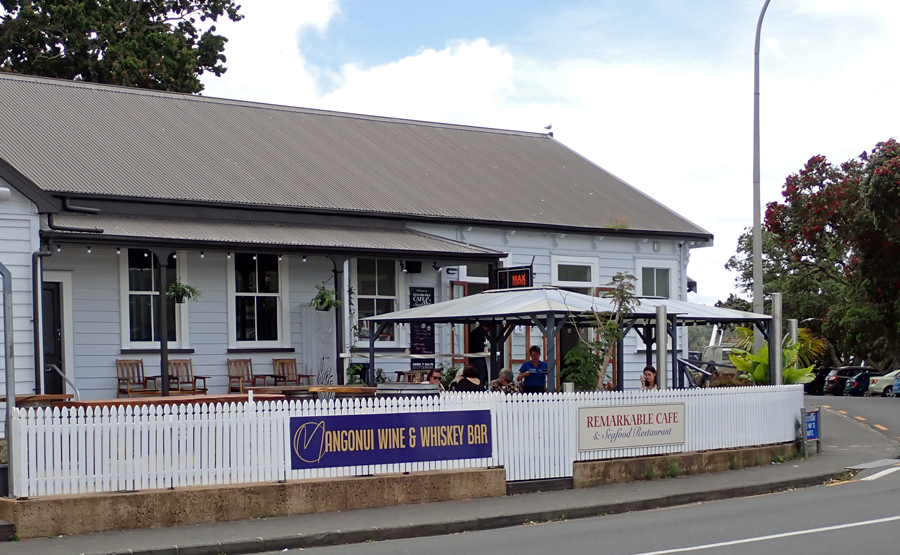
We sat outside for lunch at the Remarkable Cafe. It is chilly but tolerable. I don’t understand how places like this can stay in business. The food is inexpensive and there are plenty of open tables at peak lunchtime – there aren’t many people living here.
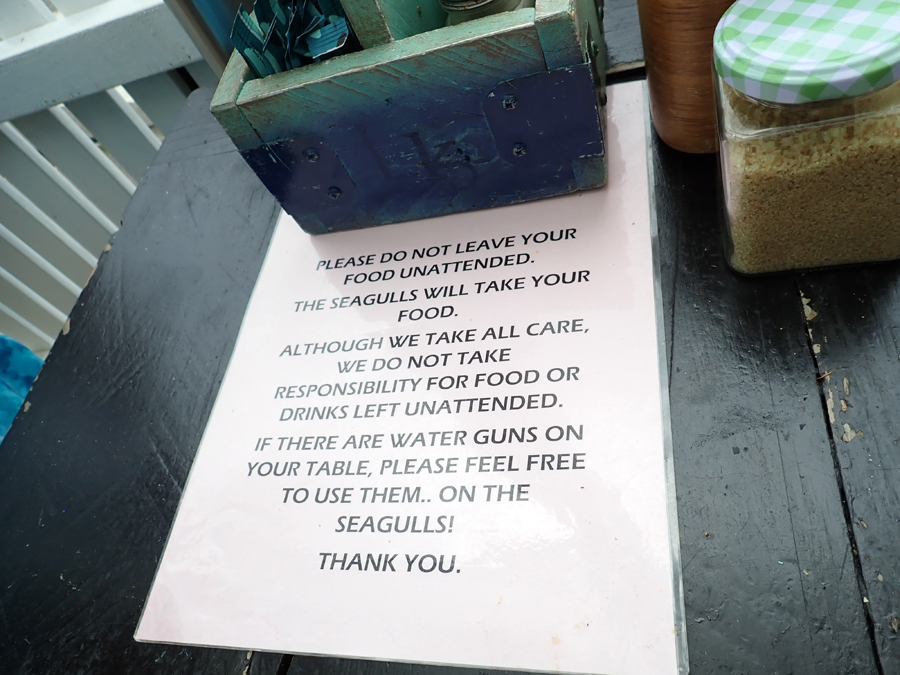
On our table. I can’t help but think in the USA you’d get real guns to kill the birds. Just kidding – I think.
Let’s talk toilets. New Zealand has great public toilets. Just about every town or park we visit has a public toilet. And for the most part, they are clean. They even have seats and toilet paper. This is completely the opposite of most French Islands we’ve visited where public toilets are as rare as hen’s teeth. On the off chance you manage to find one, it most likely will not have a seat and most certainly not have toilet paper. Kudos to New Zealand for recognizing people need to pee and poop.
The USA had over 50,000 pay toilets in 1970 but by 1980, there were almost none. Four teenagers formed the Committee to End Pay Toilets in America. Chicago became the first major American city to ban pay toilets altogether in March of 1973. Since, Americans have had to rely on nasty gas stations or a kind restaurant owner to relieve themselves. Many Americans can’t seem to grasp the concept that “stuff” is supposed to go “into” the toilet when using it and not to be used for decoration of the seat or a floor covering. Some of the interstate highways have nice(ish) rest areas. But, these are certainly not of the level of New Zealand’s public toilets. Here, they are clean and free.
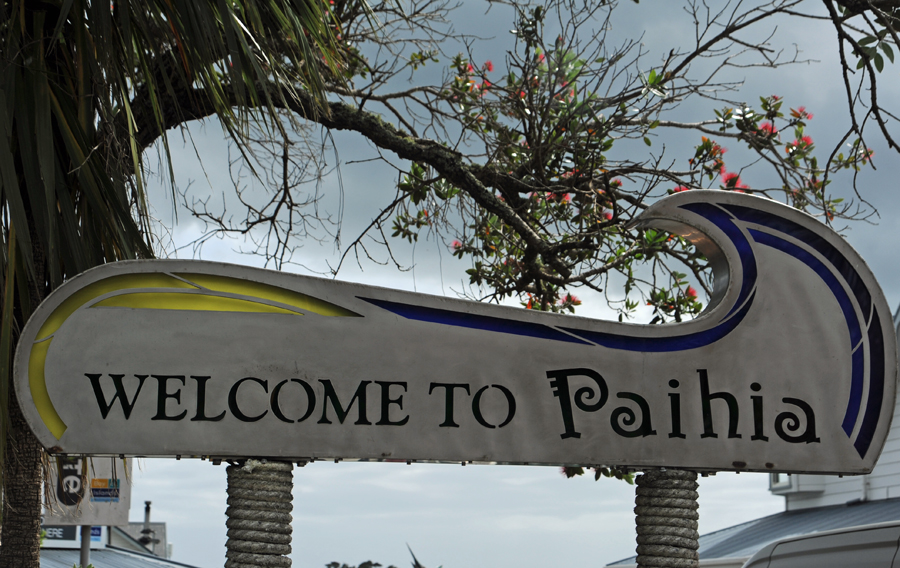
On our way back south, we stop in Paihai for lunch and a look about. This pretty town is on the Bay of Islands
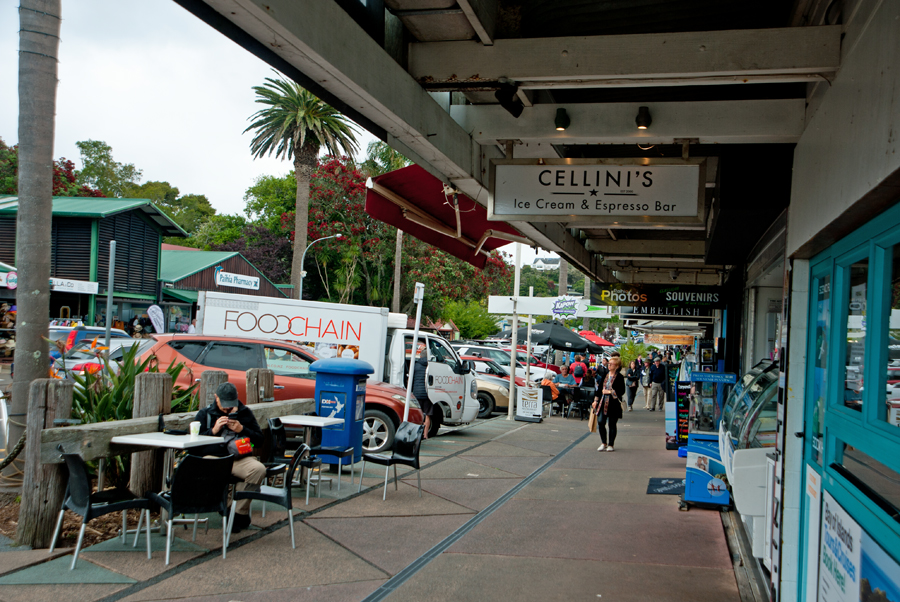
There was a cruise ship in town and a makeshift market was set up. We had burgers at a place near downtown.
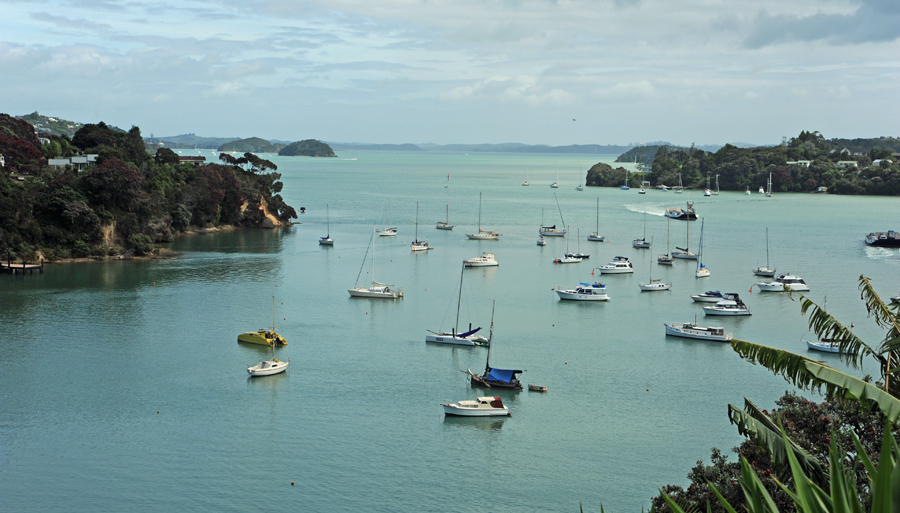
Opua, on the Bay of Islands is a popular check-in point for private vessels arriving in New Zealand. When we arrived, we opted to go further south to avoid the crowds. There is a massive marina there.
Another plus for New Zealand is that wine is cheap. I am guessing after buying gasoline/petrol, people have little money to spend on luxuries like wine. New Zealand boasts a large array of top-quality wineries. Unfortunately, when we see them, they don’t appear to be open to the public for tastings. One of the things we’ve enjoyed in other countries is winery restaurants where they pair their wines to their menu items. A lunch can be a little costly but the experience is usually so unique it’s worth the money. I hope we can find something like this in New Zealand.
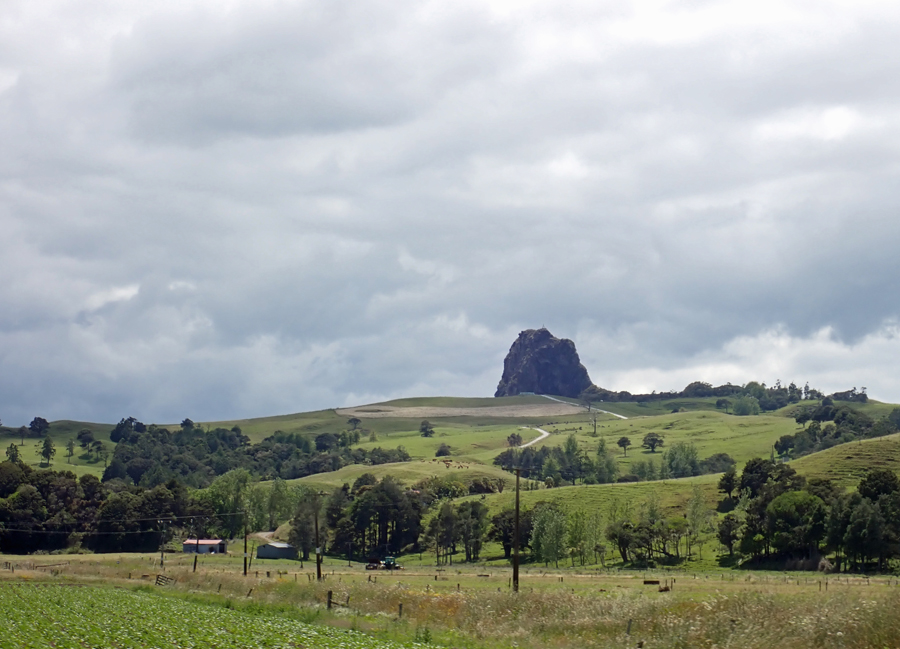
Maungaraho Rock is climbable. It is said to offer fantastic views from the summit. We’ll take their word on this.
We found Costco! Costco just opened their first store in New Zealand. Our USA membership works here. As of yet, they don’t have an online shopping store, but give them time. They’ll probably do like Amazon and have a distribution center in Australia (where they have 15 locations) and ship to New Zealand from there. This is the biggest Costco we’ve ever seen. The parking is 2 levels on the roof. Needless to say, we filled our rental car with stuff. And yes, they sell a hotdog and soda for NZ$1.99.
